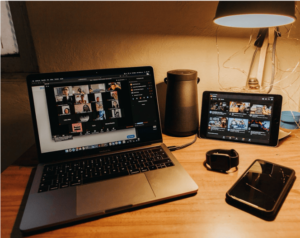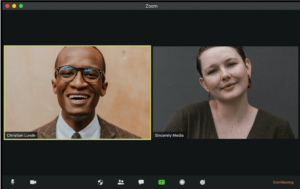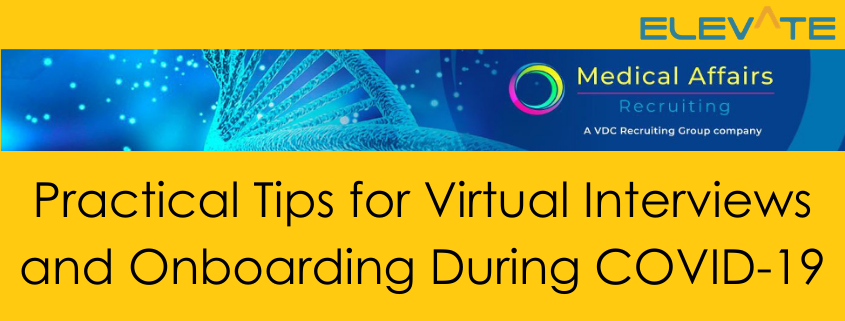Practical Tips for Virtual Interviews and Onboarding During COVID-19
Practical Tips for Virtual Interviews and Onboarding During COVID-19
COVID-19 has wildly accelerated our transition to remote interviews, onboarding, and virtual work. Your organization will quickly fall behind the 8 ball if you don’t adapt. Pharmaceutical and biotech companies can’t afford that risk. For the Medical Affairs industry, what’s the alternative to virtual hiring right now? Hazmat suit interviews? If employees can produce great work in an office, they can produce great work anywhere. There’s just one catch – how can you determine if a potential employee is capable of great work when you haven’t met them in person? How can our industry interview and hire reliable team members virtually rather than face-to-face?
As someone who has helped lead the recruitment charge since the outbreak of coronavirus, I have actionable advice for any Medical Affairs team attempting to hire through the pandemic.
 In short – if you don’t trust someone enough to hire them remotely, you shouldn’t trust them to work for your organization in any capacity. Epidemiologists from every corner of the world are hiring right now (in dozens of different languages) to make new discoveries via remote technologies like Zoom. Your team can do the same. They just need to know how.
In short – if you don’t trust someone enough to hire them remotely, you shouldn’t trust them to work for your organization in any capacity. Epidemiologists from every corner of the world are hiring right now (in dozens of different languages) to make new discoveries via remote technologies like Zoom. Your team can do the same. They just need to know how.
Most hiring managers believe that face-to-face interviews help manifest a certain personal connection. They’re absolutely correct. However, it’s downright reckless to base hiring decisions off of this alone. Such a connection is nothing more than a measure of likability rather than a consideration of legitimate factors like work history, education, and subject matter expertise. If anything, virtual interviews bring these important qualities front and center.
If your virtual hiring process is to succeed, your company must have specific processes in place. Most remote interview setups motivated by a global pandemic aren’t going to be wildly productive unless these are followed.
 Video chats should be the preferred medium for your hiring process. Webex, Skype, Zoom, and Google Meet all do the same thing. Choose whatever tool you believe is easiest to navigate and understand. Whatever you select – consistency matters for new recruits and employers alike. Don’t alternate between platforms.
Video chats should be the preferred medium for your hiring process. Webex, Skype, Zoom, and Google Meet all do the same thing. Choose whatever tool you believe is easiest to navigate and understand. Whatever you select – consistency matters for new recruits and employers alike. Don’t alternate between platforms.
Most individuals have a natural (albeit, slightly narcissistic) tendency to spend half their Zoom call looking at themselves to make sure everything appears alright on their end. Stop doing that! Resist the urge! Start making digital eye contact, instead.
Lighting is important during video interviews. Whether it’s a home office with blinding amounts of natural light or a poorly lit room that looks like a cave, you need to find a happy medium for your interviews. Simple light fixtures behind the camera can easily solve any darkness problem. If your image is too bright, just ensure the screen isn’t facing a window.
In a typical face-to-face interview, informal ‘get to know you’ questions only occur in the first 3-5 minutes of a conversation. We suggest you ask three times as many of these informal questions when speaking with potential remote candidates. This can help build a certain foundation of understanding and trust that would otherwise be forfeited due to a lack of physical presence.
The personal qualities that companies seek in remote employees differ slightly from the qualities of a standard medical affairs hire. If you think they may need to start their first day from a home office, look for stories where they were calm under pressure or quick on their feet. Seek out personality traits such as dedication, resourcefulness, and adaptability.
Cornell University recently conducted workplace research on the topic of virtual hiring. They partnered with Fortune 500 companies like IBM, Citigroup, and Cisco – all organizations with significant remote work experience. These three enterprises listed self-motivation, self-discipline, effective communication, and tech-competency as the professional traits most correlated to remote success.
Good interview questions might involve asking how they intend to structure their first day of work. How do they intend to meet co-workers? How will they seek to better understand their work and the company culture? It’s equally important that your team has the answer to these questions, as well.
Burnout, isolation, work-related anxiety, lackluster cultures – they’re all very real risks for remote onboarding, but they’re avoidable. Companies new to these remote processes will prop up workflows that barely scrape by because they don’t yet know a better way.

Here is the better way:
Hiring teams should over-communicate every step of the way. Explain your anticipated schedule to potential hires so they know what to expect. Share all pertinent information with them.
Managers should make a list of roadblock issues. Adopt a ‘continuous improvement’ mindset to resolve these issues for future onboarding classes. You should always seek to learn more.
Teams can have high expectations for candidates while simultaneously recognizing that this is a stressful time for your entire team. Be professional – but understanding. If a dog barks or a kid screams during the interview, it’s not a negative sign. It’s life.
Remote hiring may seem intimidating if your company isn’t yet accustomed to such a practice, but thousands of teams make it work. Some just do it better than others. Now is the time for Medical Affairs professionals to get [remote]ivated!

Whitney Morris
Recruiting Specialist
Medical Affairs Recruiting [email protected]
+1 910-742-7620





